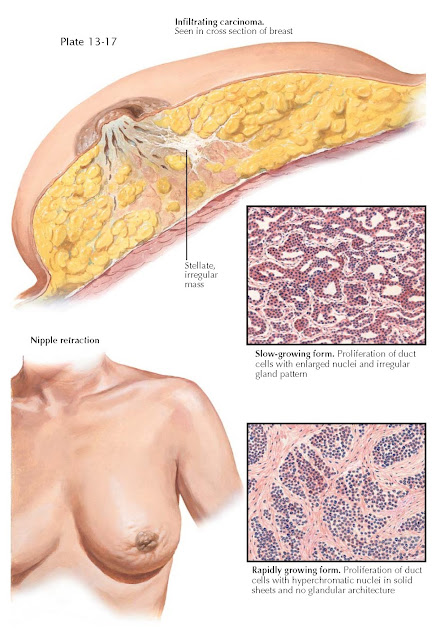BREAST CANCER
Women in the United States have the highest incidence rates of breast cancer in the world. Worldwide, breast cancer is the second most common type of cancer after lung cancer (10.4% of all cancer incidence, both sexes counted) and the fifth most common cause of cancer death. Approximately one-third of all forms of female carcinoma arise in the breast, and more than three- quarters of these are the infiltrating scirrhous type or lobular carcinoma. Breast cancer accounts for approximately 18% of cancer deaths and results in about the same number of deaths per year as auto accidents. The peak incidence is above 40 years of age; with 85% occurring after 40 and 75% after 50. Approximately 5% to 10% of breast cancers have a familial or genetic link. The symptoms that bring the patient under examination are the discovery of the lump (55% to 65% of cases), its increasing size, occasional fleeting pains or tenderness, and changes in the skin or nipple. Approximately 60% of palpable tumors are located in the upper outer quadrant of the breast. An abnormal mammogram without a palpable mass is the second most common cause for diagnosis (35%). One quarter of all breast cancers are found during routine examination.
The major clinical findings on
examination are the presence of a single lump in a breast otherwise normal to
palpation in a patient more than 35 years old; the hard and irregular feeling
of the tumor; the apparent nearness of the tumor to the examining fingers
because of atrophy of overlying fat; the restricted mobility of the mass; and
flattening or retraction of the skin or nipple on the affected side when arms or
breast are manipulated. Excisional biopsy with or without radio- graphic
control provides the only definitive diagnosis.
Grossly, mammary carcinoma is a
dense, yellowish-white, stellate, indurated mass with a cut surface that is
gritty and concave and that feels like an unripe pear. Unless secondarily
infected, the growth is usually free of necrosis. It infiltrates the surrounding
fatty and fibrous stroma of the breast. Microscopically, the tumor cells are of
moderate size, with prominent hyperchromatic nuclei. The cells grow in small
nests or in cords with prominent intervening fibrous tissue. In the more slowly
growing cancers, the cells grow in scattered masses and tend to form acinar or
tubular structures. In those more rapidly growing, the cells are scattered
individually without histologic resemblance to normal structure.
The most common breast cancer
histology is the infiltrating ductal carcinoma, accounting for about 75% of
breast cancers. Scirrhous carcinoma is the most common subtype: well-demarcated
hard nodules consisting of cords and nests of malignant ductal cells
characterize it. Medullary and mucinous forms are also recognized.
At one time, radical mastectomy was
the treatment of choice, yielding 70% 5-year survival if the axillary lymph nodes were uninvolved and 20% if there was
lymph node involvement. This has given way to a much more nuanced approach that
is dependent on a number of factors: the tumor’s size; its inherent
aggressiveness, as determined by the histology of the initial lesion; the
presence of positive nodes; and the receptor status of the tumor. The major
impetus for changes in management of breast carcinoma over the past two decades
has come from a changing view regarding the biology of the disease. It has become apparent that many
women with breast cancer have systemic disease at the time of initial
diagnosis. The natural history of the developing breast carcinoma, with an
average doubling time of 100 days, results in years of growth before its
clinical discovery. Because occult vascular dissemination is likely to occur
prior to diagnosis, treatment of breast carcinoma now relies upon both local and systemic
therapy, without reliance on radical surgery.





